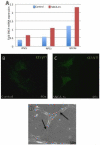Up-regulation of SNCA gene expression: implications to synucleinopathies
- PMID: 26948950
- PMCID: PMC4907864
- DOI: 10.1007/s10048-016-0478-0
Up-regulation of SNCA gene expression: implications to synucleinopathies
Abstract
Synucleinopathies are a group of neurodegenerative diseases that share a common pathological lesion of intracellular protein inclusions largely composed by aggregates of alpha-synuclein protein. Accumulating evidence, including genome wide association studies, has implicated alpha-synuclein (SNCA) gene in the etiology of synucleinopathies. However, the precise variants within SNCA gene that contribute to the sporadic forms of Parkinson's disease (PD), dementia with Lewy bodies (DLB), multiple system atrophy (MSA), and other synucleinopathies and their molecular mechanisms of action remain elusive. It has been suggested that SNCA expression levels are critical for the development of these diseases. Here, we review several model systems that have been developed to advance the understanding of the role of SNCA expression levels in the etiology of synucleinopathies. We also describe different molecular mechanisms that regulate SNCA gene expression and discuss possible strategies for SNCA down-regulation as means for therapeutic approaches. Finally, we highlight some examples that underscore the relationships between the genetic association findings and the regulatory mechanisms of SNCA expression, which suggest that genetic variability in SNCA locus is directly responsible, at least in part, to the changes in gene expression and explain the reported associations of SNCA with synucleinopathies. Future studies utilizing induced pluripotent stem cells (iPSCs)-derived neuronal lines and genome editing by CRISPR/Cas9, will allow us to validate, characterize, and manipulate the effects of particular cis-genetic variants on SNCA expression. Moreover, this model system will enable us to compare different neuronal and glial lineages involved in synucleinopathies representing an attractive strategy to elucidate-common and specific-SNCA-genetic variants, regulatory mechanisms, and vulnerable expression levels underlying synucleinopathy spectrum disorders. This forthcoming knowledge will support the development of precision medicine for synucleinopathies.
Keywords: Gene expression; Genetic regulation; SNCA; Synucleinopathies.
Figures


Similar articles
-
Structural variants in SNCA gene and the implication to synucleinopathies.Curr Opin Genet Dev. 2017 Jun;44:110-116. doi: 10.1016/j.gde.2017.01.014. Epub 2017 Mar 2. Curr Opin Genet Dev. 2017. PMID: 28319736 Free PMC article. Review.
-
Genetics of Synucleinopathies.Cold Spring Harb Perspect Med. 2018 Jun 1;8(6):a024109. doi: 10.1101/cshperspect.a024109. Cold Spring Harb Perspect Med. 2018. PMID: 28213435 Free PMC article. Review.
-
Genetic analysis of α-synuclein 3' untranslated region and its corresponding microRNAs in relation to Parkinson's disease compared to dementia with Lewy bodies.Alzheimers Dement. 2017 Nov;13(11):1237-1250. doi: 10.1016/j.jalz.2017.03.001. Epub 2017 Apr 18. Alzheimers Dement. 2017. PMID: 28431219 Free PMC article.
-
ɑ-Synuclein strains and the variable pathologies of synucleinopathies.J Neurochem. 2016 Oct;139 Suppl 1:256-274. doi: 10.1111/jnc.13595. Epub 2016 Mar 30. J Neurochem. 2016. PMID: 26924014 Review.
-
Investigation of somatic CNVs in brains of synucleinopathy cases using targeted SNCA analysis and single cell sequencing.Acta Neuropathol Commun. 2019 Dec 23;7(1):219. doi: 10.1186/s40478-019-0873-5. Acta Neuropathol Commun. 2019. PMID: 31870437 Free PMC article.
Cited by
-
Interrogating Parkinson's disease associated redox targets: Potential application of CRISPR editing.Free Radic Biol Med. 2019 Nov 20;144:279-292. doi: 10.1016/j.freeradbiomed.2019.06.007. Epub 2019 Jun 12. Free Radic Biol Med. 2019. PMID: 31201850 Free PMC article. Review.
-
Lentiviral Vector Platform for the Efficient Delivery of Epigenome-editing Tools into Human Induced Pluripotent Stem Cell-derived Disease Models.J Vis Exp. 2019 Mar 29;(145):10.3791/59241. doi: 10.3791/59241. J Vis Exp. 2019. PMID: 30985756 Free PMC article.
-
Genetic Analysis and Literature Review of SNCA Variants in Parkinson's Disease.Front Aging Neurosci. 2021 Aug 12;13:648151. doi: 10.3389/fnagi.2021.648151. eCollection 2021. Front Aging Neurosci. 2021. PMID: 34456707 Free PMC article.
-
Single-nucleus multi-omics of Parkinson's disease reveals a glutamatergic neuronal subtype susceptible to gene dysregulation via alteration of transcriptional networks.Acta Neuropathol Commun. 2024 Jul 2;12(1):111. doi: 10.1186/s40478-024-01803-1. Acta Neuropathol Commun. 2024. PMID: 38956662 Free PMC article.
-
Genomic analyses of intricate interaction of TE-lncRNA overlapping genes with miRNAs in human diseases.Genes Genomics. 2024 Nov;46(11):1313-1325. doi: 10.1007/s13258-024-01547-1. Epub 2024 Aug 31. Genes Genomics. 2024. PMID: 39215947
References
-
- Galvin JE, Lee VM, Trojanowski JQ. Synucleinopathies: clinical and pathological implications. Arch Neurol. 2001;58:186–190. - PubMed
-
- Marti MJ, Tolosa E, Campdelacreu J. Clinical overview of the synucleinopathies. Mov Disord 18 Suppl. 2003;6:S21–27. doi:10.1002/mds.10559. - PubMed
-
- Spillantini MG. Parkinson's disease, dementia with Lewy bodies and multiple system atrophy are alpha-synucleinopathies. Parkinsonism & related disorders. 1999;5:157–162. - PubMed
-
- Jellinger KA. Neuropathological spectrum of synucleinopathies. Mov Disord. 2003;18(Suppl 6):S2–12. doi:10.1002/mds.10557. - PubMed
Publication types
MeSH terms
Substances
Grants and funding
LinkOut - more resources
Full Text Sources
Other Literature Sources
Miscellaneous

